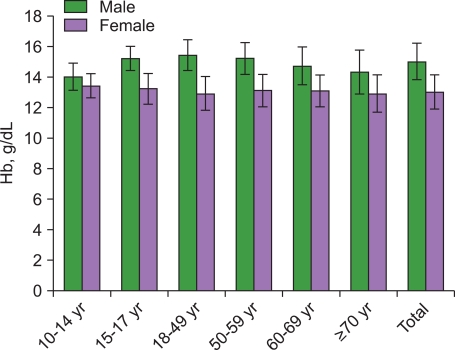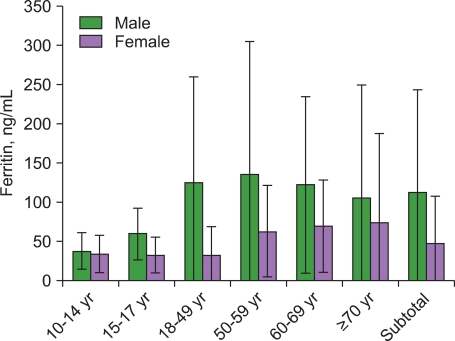Korean J Hematol.
2011 Sep;46(3):196-199. 10.5045/kjh.2011.46.3.196.
The prevalence of anemia and iron depletion in the population aged 10 years or older
- Affiliations
-
- 1Department of Pediatrics, College of Medicine, Inha University Hospital, Incheon, Korea. pedkim@inha.ac.kr
- 2Department of Internal Medicine, College of Medicine, Inha University Hospital, Incheon, Korea.
- 3Korea Center for Disease Control & Prevention, Seoul, Korea.
- KMID: 2252004
- DOI: http://doi.org/10.5045/kjh.2011.46.3.196
Abstract
- BACKGROUND
Anemia and iron depletion continue to be common disorders in the world. This study was aimed at assessing the prevalence of anemia and iron depletion in apparently healthy Koreans aged 10 years or more.
METHODS
We used the data of the 4th Korean National Health & Nutrition Examination Survey (KNHANES), which assessed 7,607 individuals (3,337 males and 4,270 females). Iron depletion was defined as serum ferritin less than 15 ng/mL.
RESULTS
In males, mean hemoglobin (Hb) concentration decreased after the age of 50. The prevalence of anemia was 7.1% in 60 to 69 year olds and 12.3% in men aged 70 or older. As for females, the prevalence of anemia was 8.8% in 15 to 17 year olds, 16.7% in 18 to 49 year olds, 10.9% in 60 to 69 year olds, and 18.2% women aged 70 or older. In males, the prevalence of iron depletion was 8.6% at ages 10 to 14 years, 3.9% at 15 to 17, and 2.6% at 70 years or older. In females, the prevalence of iron depletion was 17.2% at ages 10 to 14 years, 24.1% at 15 to 17, 33.0% at 18 to 49, and 5.7% at 70 years or older. Although normocytic anemia was most common in both males and females, the proportion of microcytosis and macrocytosis increased at age 70 or older.
CONCLUSION
The prevalence of anemia and iron depletion was high in women of reproductive age and in the elderly. Considering the rapid increase in the older population, an intervention to prevent anemia and iron depletion is imperative.
Keyword
Figure
Cited by 1 articles
-
The prevalence and clinical characteristics of cancer among anemia patients treated at an outpatient clinic
Soo Jeong Kim, So Young Ha, Bo Mi Choi, Mi Yeong Lee, Jong Youl Jin, Soo Jeong Yeom, Tae Wan Kim, Young Min Kim, Keehyun Lee
Blood Res. 2013;48(1):46-50. doi: 10.5045/br.2013.48.1.46.
Reference
-
1. Wu AC, Lesperance L, Bernstein H. Screening for iron deficiency. Pediatr Rev. 2002; 23:171–178. PMID: 11986493.
Article2. Greydanus DE, Patel DR. The female athlete. Before and beyond puberty. Pediatr Clin North Am. 2002; 49:553–580. PMID: 12119865.3. Meier PR, Nickerson HJ, Olson KA, Berg RL, Meyer JA. Prevention of iron deficiency anemia in adolescent and adult pregnancies. Clin Med Res. 2003; 1:29–36. PMID: 15931282.
Article4. de Benoist B, McLean E, Egli I, Cogswell M, editors. Worldwide prevalence of anaemia 1993-2005. WHO global database on anaemia. 2008. Geneva, Switzerland: WHO Press;p. 1–40.5. Kim SK, Hong YJ, Choi JW, Pai SH, Son BK. The prevalence of iron deficiency and iron deficiency anemia in Korean adolescents. Int J Pediatr Hematol Oncol. 1998; 5:455–461.6. Choi CW, Park KH, Yoon SY, et al. Prevalence of anemia in the elderly. Korean J Med. 2001; 60:249–253.7. Chaves PH, Ashar B, Guralnik JM, Fried LP. Looking at the relationship between hemoglobin concentration and prevalent mobility difficulty in older women. Should the criteria currently used to define anemia in older people be reevaluated? J Am Geriatr Soc. 2002; 50:1257–1264. PMID: 12133021.
Article8. Penninx BW, Pahor M, Cesari M, et al. Anemia is associated with disability and decreased physical performance and muscle strength in the elderly. J Am Geriatr Soc. 2004; 52:719–724. PMID: 15086651.
Article9. Oski FA, Honig AS, Helu B, Howanitz P. Effect of iron therapy on behavior performance in nonanemic, iron-deficient infants. Pediatrics. 1983; 71:877–880. PMID: 6856400.
Article10. Lozoff B. Behavioral alterations in iron deficiency. Adv Pediatr. 1988; 35:331–359. PMID: 3055862.
Article11. Pollitt E, Hathirat P, Kotchabhakdi NJ, Missell L, Valyasevi A. Iron deficiency and educational achievement in Thailand. Am J Clin Nutr. 1989; 50(3 Suppl):687–696. PMID: 2773846.
Article12. Bruner AB, Joffe A, Duggan AK, Casella JF, Brandt J. Randomised study of cognitive effects of iron supplementation in non-anaemic iron-deficient adolescent girls. Lancet. 1996; 348:992–996. PMID: 8855856.
Article13. Halterman JS, Kaczorowski JM, Aligne CA, Auinger P, Szilagyi PG. Iron deficiency and cognitive achievement among schoolaged children and adolescents in the United States. Pediatrics. 2001; 107:1381–1386. PMID: 11389261.
Article14. Dallman PR. Biochemical basis for the manifestations of iron deficiency. Annu Rev Nutr. 1986; 6:13–40. PMID: 3524613.
Article15. Walter T, De Andraca I, Chadud P, Perales CG. Iron deficiency anemia: adverse effects on infant psychomotor development. Pediatrics. 1989; 84:7–17. PMID: 2472596.
Article16. Sandoval C, Jayabose S, Eden AN. Trends in diagnosis and management of iron deficiency during infancy and early childhood. Hematol Oncol Clin North Am. 2004; 18:1423–1438. PMID: 15511623.
Article17. Hah JO, Kang MH, Kim JH. Prevalence study of anemia among urban and rural middle school girl students. J Korean Pediatr Soc. 1990; 33:1087–1096.18. Kim TW, Kim MH, Hong YJ, et al. Iron status in adolescents and university students in Incheon. Korean J Hematol. 2001; 36:311–317.19. Kim HS, Lee BK. Cross-sectional study on the prevalence of anemia among rural elderly in Asan. Nutr Res Pract. 2008; 2:8–12. PMID: 20126358.
Article20. Bross MH, Soch K, Smith-Knuppel T. Anemia in older persons. Am Fam Physician. 2010; 82:480–487. PMID: 20822082.21. Looker AC, Dallman PR, Carroll MD, Gunter EW, Johnson CL. Prevalence of iron deficiency in the United States. JAMA. 1997; 277:973–976. PMID: 9091669.
Article22. Eicher-Miller HA, Mason AC, Weaver CM, McCabe GP, Boushey CJ. Food insecurity is associated with iron deficiency anemia in US adolescents. Am J Clin Nutr. 2009; 90:1358–1371. PMID: 19776137.
Article23. Lee KH, Kim EK, Kim MK. Iron nutritional status of female students in Kangnung National University. Korean J Community Nutr. 1997; 2:23–32.24. Florentino RF, Guirriec RM. Steckel A, editor. Prevalence of nutritional anemia in infancy and childhood with emphasis on developing countries. Iron nutrition in infancy and childhood. 1984. New York, NY: Raven Press;p. 61–74.25. DeMaeyer E, Adiels-Tegman M. The prevalence of anaemia in the world. World Health Stat Q. 1985; 38:302–316. PMID: 3878044.26. Shim JE, Yoon JH, Jeong SY, Park M, Lee YS. Status of early childhood and maternal nutrition in South Korea and North Korea. Korean J Community Nutr. 2007; 12:123–132.
- Full Text Links
- Actions
-
Cited
- CITED
-
- Close
- Share
- Similar articles
-
- The prevalence of anemia and iron depletion in the population aged 10 years or older
- The Prevalence Change of Anemia in the Population Aged 10 Years or Older: 2005 and 2009
- The Study of Anemia in Persons affected leprosy
- Repeat Blood Donors and Iron Deficiency Anemia
- The Analysis of Causes of Anemia in Persons affected leprosy



